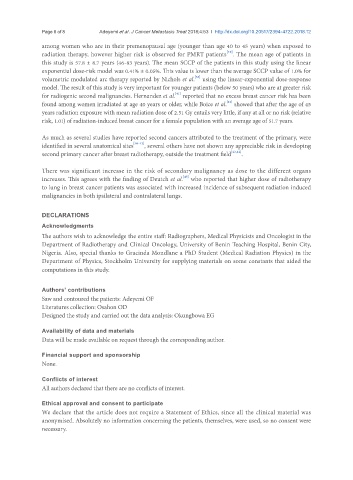Page 635 - Read Online
P. 635
Page 6 of 8 Adeyemi et al. J Cancer Metastasis Treat 2018;4:53 I http://dx.doi.org/10.20517/2394-4722.2018.12
among women who are in their premenopausal age (younger than age 40 to 45 years) when exposed to
[40]
radiation therapy, however higher risk is observed for PMRT patients . The mean age of patients in
this study is 57.8 ± 8.7 years (46-83 years). The mean SCCP of the patients in this study using the linear
exponential dose-risk model was 0.41% ± 0.05%. This value is lower than the average SCCP value of 1.0% for
[38]
volumetric modulated arc therapy reported by Nichols et al. using the linear-exponential dose-response
model. The result of this study is very important for younger patients (below 50 years) who are at greater risk
[41]
for radiogenic second malignancies. Hernandez et al. reported that no excess breast cancer risk has been
[42]
found among women irradiated at age 40 years or older, while Boice et al. showed that after the age of 45
years radiation exposure with mean radiation dose of 2.51 Gy entails very little, if any at all or no risk (relative
risk, 1.01) of radiation-induced breast cancer for a female population with an average age of 51.7 years.
As much as several studies have reported second cancers attributed to the treatment of the primary, were
identified in several anatomical sites [40-42] , several others have not shown any appreciable risk in developing
second primary cancer after breast radiotherapy, outside the treatment field [43,44] .
There was significant increase in the risk of secondary malignancy as dose to the different organs
[45]
increases. This agrees with the finding of Deutch et al. who reported that higher dose of radiotherapy
to lung in breast cancer patients was associated with increased incidence of subsequent radiation induced
malignancies in both ipsilateral and contralateral lungs.
DECLARATIONS
Acknowledgments
The authors wish to acknowledge the entire staff: Radiographers, Medical Physicists and Oncologist in the
Department of Radiotherapy and Clinical Oncology, University of Benin Teaching Hospital, Benin City,
Nigeria. Also, special thanks to Gracinda Mondlane a PhD Student (Medical Radiation Physics) in the
Department of Physics, Stockholm University for supplying materials on some constants that aided the
computations in this study.
Authors’ contributions
Saw and contoured the patients: Adeyemi OF
Literatures collection: Osahon OD
Designed the study and carried out the data analysis: Okungbowa EG
Availability of data and materials
Data will be made available on request through the corresponding author.
Financial support and sponsorship
None.
Conflicts of interest
All authors declared that there are no conflicts of interest.
Ethical approval and consent to participate
We declare that the article does not require a Statement of Ethics, since all the clinical material was
anonymised. Absolutely no information concerning the patients, themselves, were used, so no consent were
necessary.

